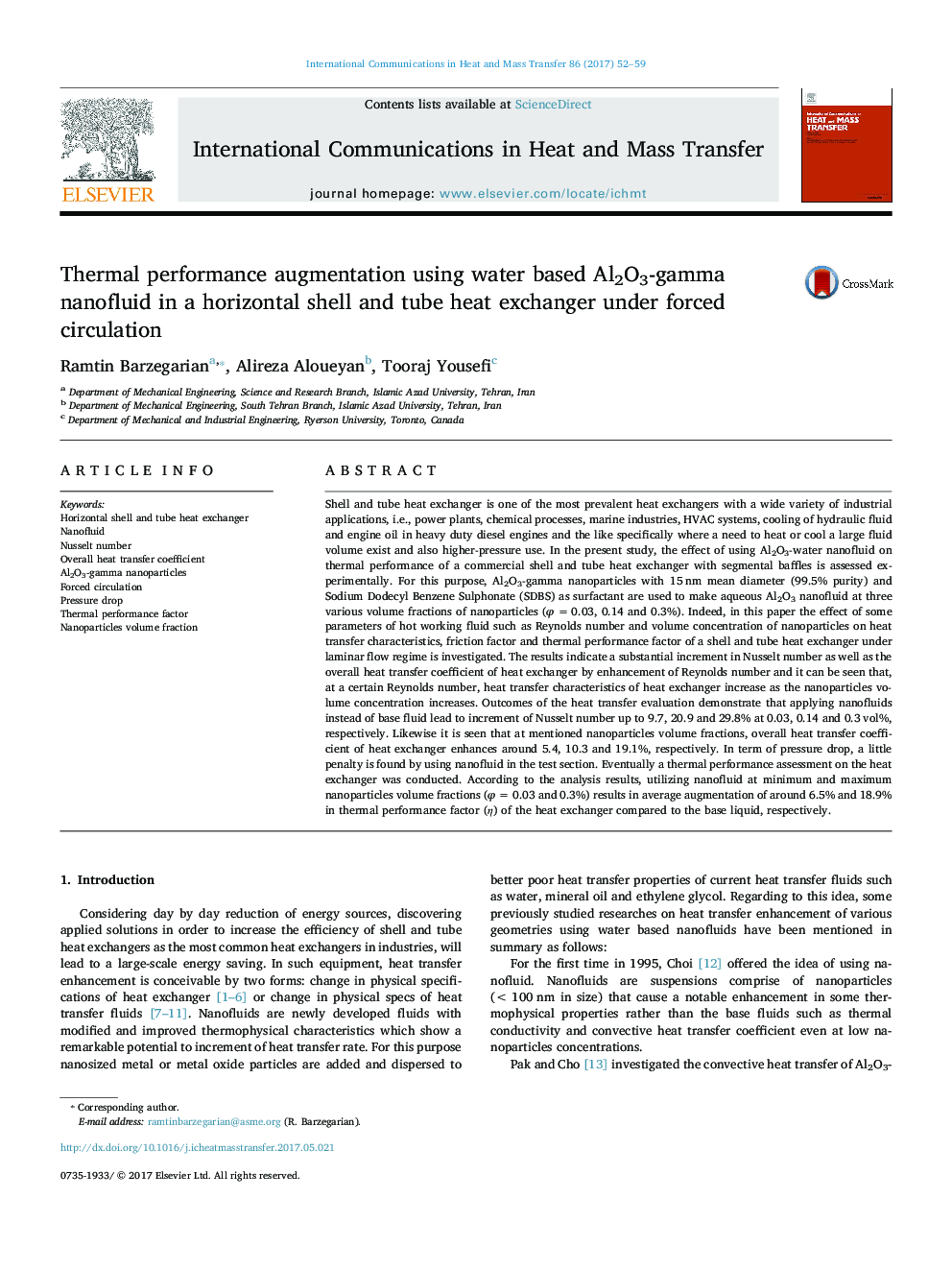| کد مقاله | کد نشریه | سال انتشار | مقاله انگلیسی | نسخه تمام متن |
|---|---|---|---|---|
| 4992849 | 1457468 | 2017 | 8 صفحه PDF | دانلود رایگان |
عنوان انگلیسی مقاله ISI
Thermal performance augmentation using water based Al2O3-gamma nanofluid in a horizontal shell and tube heat exchanger under forced circulation
دانلود مقاله + سفارش ترجمه
دانلود مقاله ISI انگلیسی
رایگان برای ایرانیان
کلمات کلیدی
موضوعات مرتبط
مهندسی و علوم پایه
مهندسی شیمی
جریان سیال و فرایندهای انتقال
پیش نمایش صفحه اول مقاله

چکیده انگلیسی
Shell and tube heat exchanger is one of the most prevalent heat exchangers with a wide variety of industrial applications, i.e., power plants, chemical processes, marine industries, HVAC systems, cooling of hydraulic fluid and engine oil in heavy duty diesel engines and the like specifically where a need to heat or cool a large fluid volume exist and also higher-pressure use. In the present study, the effect of using Al2O3-water nanofluid on thermal performance of a commercial shell and tube heat exchanger with segmental baffles is assessed experimentally. For this purpose, Al2O3-gamma nanoparticles with 15 nm mean diameter (99.5% purity) and Sodium Dodecyl Benzene Sulphonate (SDBS) as surfactant are used to make aqueous Al2O3 nanofluid at three various volume fractions of nanoparticles (Ï = 0.03, 0.14 and 0.3%). Indeed, in this paper the effect of some parameters of hot working fluid such as Reynolds number and volume concentration of nanoparticles on heat transfer characteristics, friction factor and thermal performance factor of a shell and tube heat exchanger under laminar flow regime is investigated. The results indicate a substantial increment in Nusselt number as well as the overall heat transfer coefficient of heat exchanger by enhancement of Reynolds number and it can be seen that, at a certain Reynolds number, heat transfer characteristics of heat exchanger increase as the nanoparticles volume concentration increases. Outcomes of the heat transfer evaluation demonstrate that applying nanofluids instead of base fluid lead to increment of Nusselt number up to 9.7, 20.9 and 29.8% at 0.03, 0.14 and 0.3 vol%, respectively. Likewise it is seen that at mentioned nanoparticles volume fractions, overall heat transfer coefficient of heat exchanger enhances around 5.4, 10.3 and 19.1%, respectively. In term of pressure drop, a little penalty is found by using nanofluid in the test section. Eventually a thermal performance assessment on the heat exchanger was conducted. According to the analysis results, utilizing nanofluid at minimum and maximum nanoparticles volume fractions (Ï = 0.03 and 0.3%) results in average augmentation of around 6.5% and 18.9% in thermal performance factor (η) of the heat exchanger compared to the base liquid, respectively.
ناشر
Database: Elsevier - ScienceDirect (ساینس دایرکت)
Journal: International Communications in Heat and Mass Transfer - Volume 86, August 2017, Pages 52-59
Journal: International Communications in Heat and Mass Transfer - Volume 86, August 2017, Pages 52-59
نویسندگان
Ramtin Barzegarian, Alireza Aloueyan, Tooraj Yousefi,